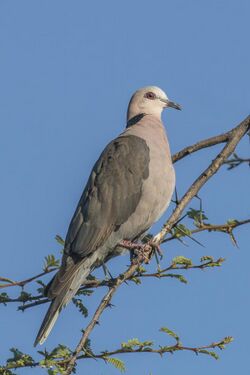Biology:Red-eyed dove
| Red-eyed dove | |
|---|---|

| |
| File:Streptopelia semitorquata, roepe, Hartbeesfontein, 2022-05-28 15h52, a.mp3 | |
| Red-eyed dove in Zimbabwe, and a recording of the bird from South Africa | |
| Scientific classification | |
| Domain: | Eukaryota |
| Kingdom: | Animalia |
| Phylum: | Chordata |
| Class: | Aves |
| Order: | Columbiformes |
| Family: | Columbidae |
| Genus: | Streptopelia |
| Species: | S. semitorquata
|
| Binomial name | |
| Streptopelia semitorquata (Rüppell, 1837)
| |
The red-eyed dove (Streptopelia semitorquata) is a dove that is widespread and common in Sub-Saharan Africa. It has been listed as Least Concern on the IUCN Red List since 2004.[1]
Taxonomy
The red-eyed dove was formally described by the German naturalist Eduard Rüppell in 1835 from birds seen in the Taranta Mountains of Eritrea. He coined the binomial name Columba semitorquata.[2][3] The specific epithet is combines the Latin semi- meaning "half-" or "small" and torquatus meaning "collared".[4] The species is monotypic: no subspecies are recognised.[5]
Description
The red-eyed dove is a largish, stocky pigeon, typically 30 cm (12 in) in length. Its back, wings and tail are pale brown. When flying, it shows blackish flight feathers. The head and underparts are dark vinous-pink, shading to pale grey on the face. There is a black hind neck patch edged with white. The legs and a patch of bare skin around the eye are red. The call is a loud doo-doo-du-du.
Sexes are similar, but juveniles are duller than adults and have scalloping on the body feathers.
Red-eyed doves eat grass seeds, grains and other vegetation. They often forage on the ground.
Distribution and habitat
It is distributed through most of Sub-Saharan Africa, except in desert zones. It is a common, if not abundant, species in most habitats other than deserts. Like several other species in this genus, they are not particularly gregarious and often feed alone or in pairs. They can be found in forests near rivers.
Behaviour
This species builds a stick nest in a tree and lays two white eggs. Its flight is quick, with the regular beats and an occasional sharp flick of the wings, which are characteristic of pigeons in general.
References
- ↑ 1.0 1.1 BirdLife International (2016). "Streptopelia semitorquata". IUCN Red List of Threatened Species 2016: e.T22690499A93275741. doi:10.2305/IUCN.UK.2016-3.RLTS.T22690499A93275741.en. https://www.iucnredlist.org/species/22690499/93275741. Retrieved 19 November 2021.
- ↑ Rüppell, Eduard (1835) (in de). Neue Wirbelthiere zu der Fauna von Abyssinien gehörig. Vögel. Frankfurt am Main: S. Schmerber. pp. 66–67, Plate 23 fig. 2. https://www.biodiversitylibrary.org/page/37140154.
- ↑ Peters, James Lee, ed (1937). Check-List of Birds of the World. 3. Cambridge, Massachusetts: Harvard University Press. p. 93. https://www.biodiversitylibrary.org/page/14477808.
- ↑ Jobling, James A. (2010). The Helm Dictionary of Scientific Bird Names. London: Christopher Helm. p. 353. ISBN 978-1-4081-2501-4.
- ↑ Gill, Frank; Donsker, David; Rasmussen, Pamela, eds (2020). "Pigeons". IOC World Bird List Version 10.1. International Ornithologists' Union. https://www.worldbirdnames.org/bow/pigeons/.
- "Red-eyed dove." Britannica School. Encyclopædia Britannica, Inc., 2015. Web. 1 Oct. 2015.
- Birds of The Gambia by Barlow, Wacher and Disley. ISBN:1-873403-32-1
External links
- Red-eyed dove - Species text in The Atlas of Southern African Birds.
Wikidata ☰ Q1072609 entry
 |




